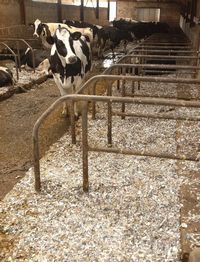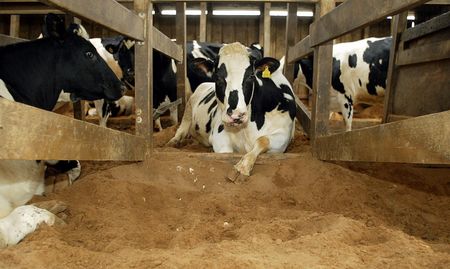Bedding choice could lead to cost savings

High prices and tight supply are the two main features of the straw market this year, leaving many livestock producers seeking alternative sources of bedding. But price and availability are not the only factors to consider. Alternative bedding must prove comfortable, safe, absorbent and easy to deal with – not always a simple set of requirements to meet.
Bedding type and how it is managed can affect cow health as well as staff health, says Martin Yeates, technical manager at Kingshay Farming Trust. “When considering changing to a new bedding type, you must look at all aspects of its cost – from purchase price to management requirements.”
| Sawdust |
|---|
|
Purchase prices have increased by about £10/t for wheat straw over the past year, and £15-£20/t for barley straw, says Devon-based merchant John Dorse. “A lot of it is having to be brought in from East Anglia, which adds to haulage costs.”
A £15/t increase in price will typically increase cubicle bedding costs by £1125 for a 150-cow herd, says Dr Yeates. Changing  to an alternative bedding could, therefore, lead to considerable savings.
to an alternative bedding could, therefore, lead to considerable savings.
“Find out what alternatives to straw are available in your area and question whether you will need to adapt cubicle beds or invest in new bedding machinery,” he says. “You must consider absorbency, comfort level, potential disease hazard and impact on your slurry system.” Storage is also important, as are consistency of supply, ease of handling and the frequency with which bedding needs to be changed – all of which can have an impact on overall management cost.
“Only change bedding type when it brings benefits to cow health as well as being financially worthwhile,” says Dr Yeates. “Small savings in bedding costs can easily be lost by decreases in cow health.”
One of the most difficult bed types to replace is deep litter, to which straw is perfectly suited. Sawdust and sand can be used, but another option is to put rape straw underneath wheat or barley straw to eke out limited straw supplies, he adds.
Oliver Latter, director of Gloucestershire resource recovery company Boomeco, says demand for alternative bedding is outstripping supply this year. “The price of straw has just rocketed and demand is high because of the wet summer.”
Boomeco supplies sawdust to dairy and beef farmers for use in cubicles and loose housing and is finding such demand in the south-west that it has a one-month waiting list.
However, it will soon be opening up new sites in Sussex, Dorset, Somerset and Essex, which it hopes will enable it to keep pace with demand.
| Straw |
|---|
|
| Sand |
|---|
|
The benefits of sawdust are that it is dry and absorbent, adaptable to deep litter or cubicle systems, easy to handle and muck out, and cheap to procure, says Mr Latter. Prices start from about £20/t delivered, and each tonne will cover 100-120sq m at a 5cm (2in) depth.
“It goes a lot further than straw and is absorbent – our farmers are only bedding up once a week, and letting cows spread it about, which saves a lot of time and effort. Some of our customers are selling their straw and buying sawdust instead.”
Sawdust is also compatible with most slurry systems and can be spread on land after composting down, says Mr Latter. It is also clean and does not cling to animals, making preparation for market far easier. The same is also true of sand and paper bedding, both of which are clean and healthy materials.
One drawback to sawdust is that it can be dusty. But although Mr Latter did have some initial concerns about mastitis and dust-induced respiratory diseases, practice has shown bedding has not caused any such problems.
“But recovered timber is quite a new market and quality is one of the main issues.”
Farmers should, therefore, take care to find out the source of sawdust, how dry it is, and the uniformity of chop, he adds. “Some farmers are using virgin sawdust from sawmills, but that’s about 50% moisture which causes all sorts of problems – it certainly couldn’t be used in dairy units.”

Sand is popular option for many dairy units, but it can pose problems for many slurry handling systems.
| Paper products |
|---|
|
| Case study Adrian Palmer – Holsworthy, devon
|
